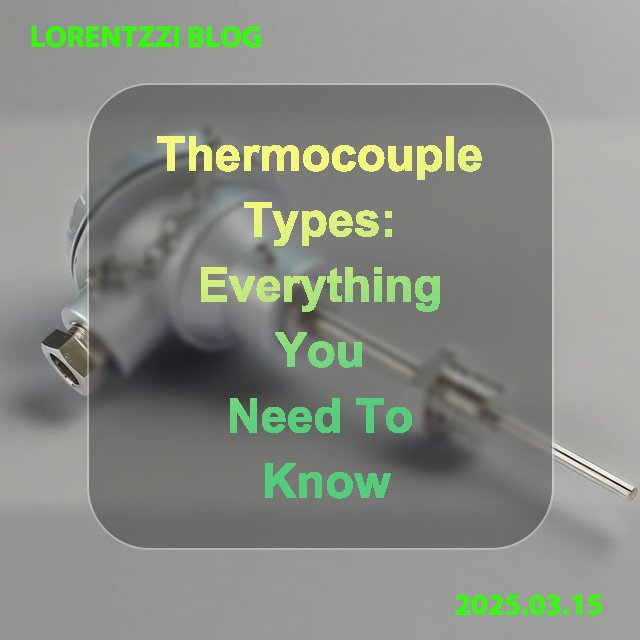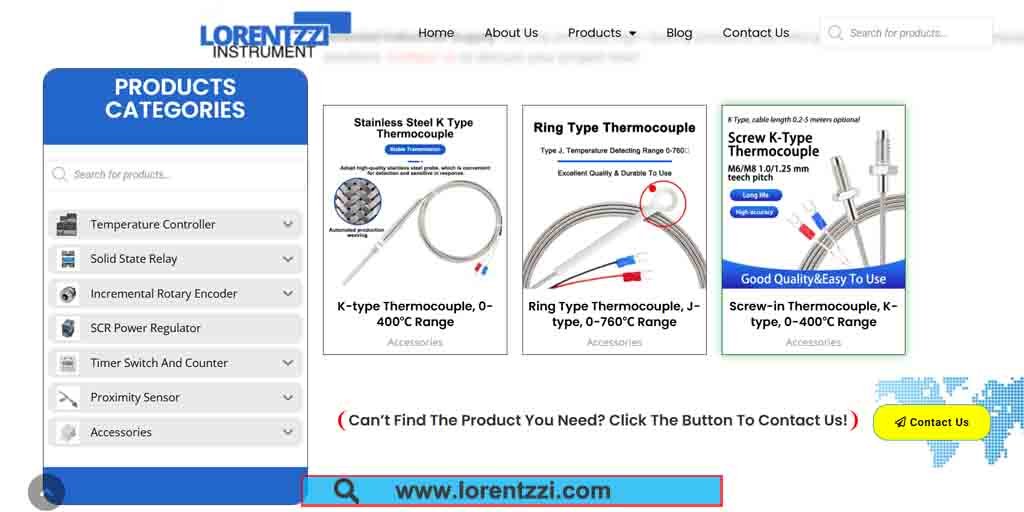Ao escolher um termopar, você pode achar que há muitos tipos de termopares disponíveis no mercado. Ainda está em dúvida sobre qual é o melhor tipo para a sua aplicação? Este artigo listará todos os termopares e suas vantagens e desvantagens. Agora, vamos começar!

O princípio de funcionamento dos termopares é baseado no efeito termoelétrico (efeito Seebeck). Quando dois condutores de materiais diferentes de um termopar formam um circuito fechado e a extremidade quente e a extremidade fria estão em temperaturas diferentes, uma pequena força eletromotriz (chamada simplesmente de Emf) será gerada no circuito.
Há uma certa relação entre essa força termoelétrica e a diferença de temperatura. Ao medir a força termoelétrica e combiná-la com as curvas de temperatura-tensão acima, a temperatura do objeto que está sendo medido pode ser calculada.
De modo geral, os termopares podem ser divididos em tipo K, tipo J, tipo E, tipo T, tipo N, tipo B, tipo S, tipo R, tipo C e tipo M. Nós os explicaremos um a um nos capítulos seguintes.
Termopar tipo K

O termopar tipo K é o mais usado entre os 10 tipos de termopares.
Material: liga de níquel-cromo (eletrodo positivo) - liga de níquel-silício ou níquel-alumínio (eletrodo negativo)
Faixa de medição de temperatura: -200℃ a +1300℃
Características: alta precisão, boa estabilidade, baixo preço e o mais amplamente utilizado.
Cenários de aplicação: fornos industriais, fornos de secagem, processamento de alimentos, reatores químicos, etc.
Termopar tipo J
O termopar tipo J também é um sensor de temperatura amplamente utilizado, mas sua faixa de medição de temperatura é mais estreita do que a do termopar tipo K, portanto, é mais adequado para ambientes em que a temperatura não é muito alta.
Material: Ferro (eletrodo positivo) - liga de cobre e níquel (eletrodo negativo)
Faixa de medição de temperatura: -40℃ a +750℃
Características: baixo custo, alta sensibilidade, mas como o ferro é o eletrodo positivo, o desempenho antioxidante é ruim.
Cenários de aplicação: medição de baixa temperatura, controle de temperatura de fornos, medição de temperatura de soldagem, etc.
Termopar tipo E

Conforme mostrado na figura acima, a inclinação de tensão/temperatura do termopar tipo E é a maior. Ou seja, na mesma temperatura, o termopar tipo E pode produzir a tensão mais alta em comparação com os termopares tipo K e tipo J, e sua variação com a temperatura também é a maior. Portanto, a precisão da medição de temperatura do termopar tipo E é a mais alta.
Material: níquel-cromo (eletrodo positivo) - cobre-níquel (eletrodo negativo)
Faixa de temperatura: -200℃ a +900℃
Características: Alta sensibilidade, adequada para 5 medições de alta precisão.
Cenários de aplicação: Medições na faixa de temperatura baixa a média, como equipamentos de refrigeração e equipamentos de laboratório.
Termopar tipo T

Conforme mostrado na figura acima, os termopares do tipo T têm boa linearidade em ambientes de baixa temperatura, de modo que os termopares do tipo T são usados principalmente para detecção de baixa temperatura, como em refrigeradores, câmaras frigoríficas etc.
Material: Cobre (eletrodo positivo) - Cobre-níquel (eletrodo negativo)
Faixa de temperatura: -200℃ a +400℃
Características: Adequado para medição de baixa temperatura, bom desempenho antioxidante.
Cenário de aplicação: Medição de ambientes de baixa temperatura, como equipamentos de refrigeração e tanques de armazenamento de gás liquefeito.
A seção acima apresenta os termopares metálicos de baixo custo. Na seção seguinte, discutiremos os termopares metálicos mais caros, como o Tipo B, o Tipo S e o Tipo R. Eles são caros porque a composição desses três termopares é feita de liga de platina e ródio.

A partir das curvas EMF versus temperatura dos termopares Tipo B, Tipo S e Tipo R, fica evidente que todos os três tipos têm uma capacidade de medição de temperatura máxima extremamente alta, chegando a quase 1800°C. Agora, quais são seus materiais, vantagens, desvantagens e aplicações? Agora vamos continuar aprendendo.
Termopar tipo N
Material: níquel-cromo-silício (eletrodo positivo) - níquel-silício (eletrodo negativo)
Faixa de temperatura: -200℃ a +1300℃
Características: Melhor resistência à oxidação do que o tipo K, adequado para medição de alta temperatura.
Termopar tipo B, tipo R, tipo S
O eletrodo positivo de um termopar tipo B é uma liga de platina e ródio (proporção 70:30), e o eletrodo negativo é uma liga de platina e ródio (proporção 94:6).
Os eletrodos positivos dos termopares tipo S e tipo R são de liga de platina e ródio (proporção 90:10) e de liga de platina e ródio (proporção 87:13), respectivamente, e os eletrodos negativos são de platina.
A faixa de medição de temperatura do termopar tipo B é de 200℃-1800℃, que não pode ser usada para detecção de baixa temperatura.
A faixa de medição de temperatura dos tipos S e R é de -50℃-1700℃, que pode ser usada para detecção de baixa temperatura, mas é mais adequada para fornos de alta temperatura, fornos de fundição, etc.
Termopares tipo C e tipo M

Os termopares tipo C e tipo M raramente são usados.
O eletrodo positivo do termopar tipo C é de liga de tungstênio-rênio (proporção 74:26), o eletrodo negativo é de liga de tungstênio-rênio (proporção 95:5), a faixa de temperatura é de 0℃ a +2320℃, adequada para medição de temperatura extremamente alta, mas cara.
O eletrodo positivo do termopar tipo M é de liga de platina-cobalto (proporção 70:30), o eletrodo negativo é de liga de platina-cobalto (proporção 94:6), a faixa de temperatura é de -50°C a +1800°C.
Conclusão
Em resumo, os diferentes tipos de termopares têm suas próprias vantagens e desvantagens. Os termopares tipo J e tipo K são os mais usados na medição de temperatura.
Em Lorentzzi®, não só fornecemos produtos de alta qualidade controladores de temperaturae também termopares de alta qualidade. Se você tiver dúvidas técnicas ou quiser obter uma cotação, por favor Entre em contato conosco Agora!










